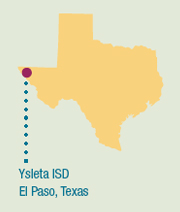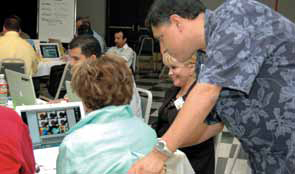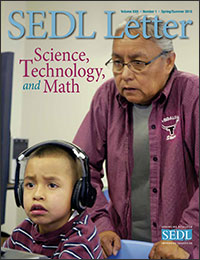Technology Training in Ysleta: SEDL's Researcher-Practitioner Relationships Pay Off
"SEDL helped us focus on what was important and helped us determine what areas we needed to do more work in. They gave us feedback in different ways: face to face, talking to people who were involved. . . . SEDL let us know if [training participants] were really getting it, if the training was purposeful and made a difference at their campus.”
— Shelley Smallwood,
Coordinator for Instructional Technology
at Ysleta Independent School District
Since 2003, SEDL's Research and Evaluation work group has provided evaluation services for several technology projects at Ysleta Independent School District (ISD) in El Paso, Texas. With SEDL's assistance, Ysleta ISD has made great progress in integrating technology into instruction and administrative work. Teachers are now employing technology to enhance project-based learning, build Web-based networks, involve parents and community, and ensure that students have the skills to meet the challenges of a technology-based society.
As a SEDL evaluator, I worked closely with Ysleta ISD on two key projects: the Teaching Constructivism and Technology Integration (TCATI) project and the Integrating Technology, Leadership, Administration and Knowledge (iTALK) project. Both have helped Ysleta ISD's Division of Academics Instructional Technology (IT) meet its goal of improving student achievement by integrating technology within the regular curriculum at every level across the district. Through the implementation and evaluation of these projects, SEDL and Ysleta IT staff also discovered the value of an extended collaboration between researchers and practitioners.
 | Established in the 1930s, Ysleta ISD is the second-largest school district in El Paso, Texas. The district has more than 3,000 teachers at 62 campuses that serve some 45,000 students. The student population is 92% Hispanic, 5% Anglo, and 2% African American, and 81% of all students are economically disadvantaged. As early as the 1990s, Ysleta operated at minimum achievement levels. But after launching significant improvement efforts, Ysleta became the first urban district in Texas to be a Recognized District for student performance on the state assessment. Today, half of the district’s campuses are exemplary or recognized. |
Teaching Constructivism and Technology Integration Project
Ysleta ISD first contacted SEDL when it began the TCATI project, funded by a Texas Education Agency (TEA) Technology Applications Readiness Grant for Empowering Texans. During the 3-year project, Ysleta IT staff aimed to improve technology integration at the campus  level. The ultimate goal was to improve student achievement by enhancing students' ability to use technology to learn academic content. The TCATI project initially involved 150 teachers from 10 Ysleta elementary schools. SEDL technology experts modeled the Active Learning With Technology (ALT) program, a series of field-tested learning modules that help teachers effectively incorporate technology into classroom instruction. By the end of the project, Ysleta IT staff had provided professional development in curriculum integration, Web publishing, and multimedia to three-person teams of first- through sixth-grade teachers from most of the district's elementary schools.
level. The ultimate goal was to improve student achievement by enhancing students' ability to use technology to learn academic content. The TCATI project initially involved 150 teachers from 10 Ysleta elementary schools. SEDL technology experts modeled the Active Learning With Technology (ALT) program, a series of field-tested learning modules that help teachers effectively incorporate technology into classroom instruction. By the end of the project, Ysleta IT staff had provided professional development in curriculum integration, Web publishing, and multimedia to three-person teams of first- through sixth-grade teachers from most of the district's elementary schools.
Professional development was not limited to technology, however. True to the project's name, teachers also learned how to base technology activities in constructivist principles—the idea that students generate knowledge based on prior experiences. For example, teachers might facilitate collaborative, problem-solving projects like using computers, digital cameras, and presentation software to research and create an electronic presentation about their community.
Evaluation was a key component of the project. SEDL's Research and Evaluation work group collaborated with Ysleta IT staff to develop an evaluation plan. We focused on both formative evaluation—through assessments occurring throughout the project—and summative evaluation—with an assessment of the project's impact once it was completed. We also determined which evaluation activities would be conducted by SEDL and which ones SEDL would complete in cooperation with Ysleta IT staff. The evaluation plan included identification of evaluation questions; specification of evaluation audiences; identification of data sources and methods used to collect data; and a timeline of evaluation activities including surveys, focus groups, and interviews.
One of the challenges of a smaller, district-level evaluation is that sufficient resources are not always available to pursue every question of interest. Instead, the evaluator must focus on the essential aspects of the evaluation. The TCATI evaluation plan prioritized the ALT professional development sessions to gather information about teachers' perceptions of their ability to use technology in instruction and to support students. Evaluation questions focused on the following: to what extent were TCATI project activities implemented as planned; did participants find the ALT workshop activities to be helpful; and did participants practice and learn to use the recommended instructional strategies?
Data were collected from surveys distributed at the end of the professional development sessions and from a general survey administered at the end of the first project year. We used the data to provide formative information to project staff about participants' perceptions of the professional development activities, technology resources, and support. This information provided ongoing feedback for making adjustments to improve the project as needed. In the second and third years of the project, we also conducted interviews with a sample of teachers to obtain information about their successes and challenges using the knowledge and skills they had acquired through the TCATI project. The evaluator included results of these interviews in the summative project reports.
The data collected during the TCATI project consistently showed that teachers perceived the professional development to be of high quality and useful in helping them plan, prepare, and implement standards-based lessons using technology in a student-centered learning environment. Similarly, Ysleta IT staff thought the entire project benefited from SEDL's evaluation. "You get a better product at the end . . . out of the feedback," says Micha Villareal, director of instructional technology at Ysleta ISD. "The informal feedback, along with the formal feedback, has been good."
Integrating Technology, Leadership,
Administration and Knowledge Project Whereas the TCATI project focused professional development on integrating technology into instruction, the iTALK project provided district and school leaders with professional development for using technology in their everyday work and for supporting the use of technology across the curriculum. Funded by a Schools, Teachers, Administrators and Regions (STAR) grant from the TEA, the project lasted from 2007 to 2009 and made new hardware and software available to district professional development staff, principals, assistant principals, counselors, and instructional specialists. Ysleta IT staff provided technology professional development to the staff that received the equipment. The project also used teams of leaders and teachers at each of the then 61 campuses to build campus-level capacity for technology professional development.

As part of the TCATI project, Ysleta ISD staff attended professional development where they learned to use new computers and software. SEDL evaluators helped Ysleta IT staff identify and meet project goals.
SEDL Research and Evaluation staff again consulted with the Ysleta IT department on the project evaluation. The team collaboratively developed an evaluation plan to obtain information that would address the most critical questions for documenting progress toward the project objectives. We used a variety of methods to collect evaluation data from multiple sources, such as workshop surveys, observations of professional development sessions, and interviews or focus groups with project participants. As consultants on the project, SEDL evaluators reviewed data that the Ysleta IT staff collected from end-of-session surveys and provided guidance for collecting additional project data that would be useful for interim and annual summative project reports. We scheduled regular phone calls with the Ysleta IT staff to discuss project events, share evaluation data and results, and plan data collection opportunities. In addition to keeping each other updated on the progress of the evaluation, these monthly conversations gave the SEDL and Ysleta IT staff ongoing opportunities for reflection and input on project activities.
The Advantages of Formative Evaluation
While small evaluation projects bring unique challenges, they also offer many benefits. One of these is the opportunity for the evaluator to work closely with program staff—asking questions, providing insights, and reflecting with staff about how to make small adjustments to their project. Ysleta ISD's experienced IT staff learned from our formative evaluations that their technology sessions already had many of the characteristics of high-quality professional development.
During the TCATI project, for example, we observed sessions where participants engaged in hands-on learning experiences that integrated technology. Teachers also reported that they appreciated opportunities to work in small groups, ask questions, and get actual experience with projects they could use in their own classrooms. We noticed, however, that not many of the teachers were making connections with the constructivist principles that served as the basis of the technology-integration activities. After providing this feedback to the IT staff, we later observed that trainers were more direct in leading teachers to identify the constructivist principles that were inherent in the technology activities.
Currently, SEDL is working with Ysleta ISD to evaluate the Ysleta Virtual School project, a TEA Vision 2020 Cycle 2 grant that involves developing virtual learning courses, teacher professional development for virtual courses, and student online learning support.
Ysleta IT staff also found formative data useful during the iTALK project. After observing an iTALK professional development session and conducting several focus group discussions with project participants over a 2-day period, we met with Ysleta IT staff to discuss our preliminary findings. We provided a general overview of what the data indicated about project strengths. For example, iTalk participants reported that the project was a good fit with district and individual goals for technology use. The participants also appreciated the grant's scope, which included administrators, counselors, and professional development specialists across the district in the initiative. In addition, they thought they could share a common language, get ideas from each other, and help one another because everyone was involved and knowledgeable.
We were also able to give IT staff feedback on participants' challenges in achieving project goals. For example, some participants mentioned that iTALK professional development sessions were sometimes a lot to digest at one time and found it difficult to keep up with the instructor. "Sometimes it's just too much, too fast," explained one participant. In response, we worked with the IT staff to brainstorm ways of making sure that participants with different levels of experience would have their needs met at the same professional development session.

During the two projects, Ysleta IT staff said they appreciated working with SEDL evaluators because of the perspective that outside observers brought to the projects. "SEDL was able to provide an external perspective based on best practices to improve processes, improve services, and thus . . . what students get in the classroom," says Villarreal.
Ysleta IT staff continue to envision ways to broaden the impact of integrative technology practices across their region. They recently invited SEDL to join with them on a grant proposal to continue the lessons learned through their district-wide, grant-funded technology projects in a collaborative relationship with two neighboring school districts. Although that project has yet to be funded, the IT staff continue to look for innovative ways to help administrators, teachers, and campus personnel maximize the use of technology to enhance student learning and achievement.
Next Article: On the Road With Technology

